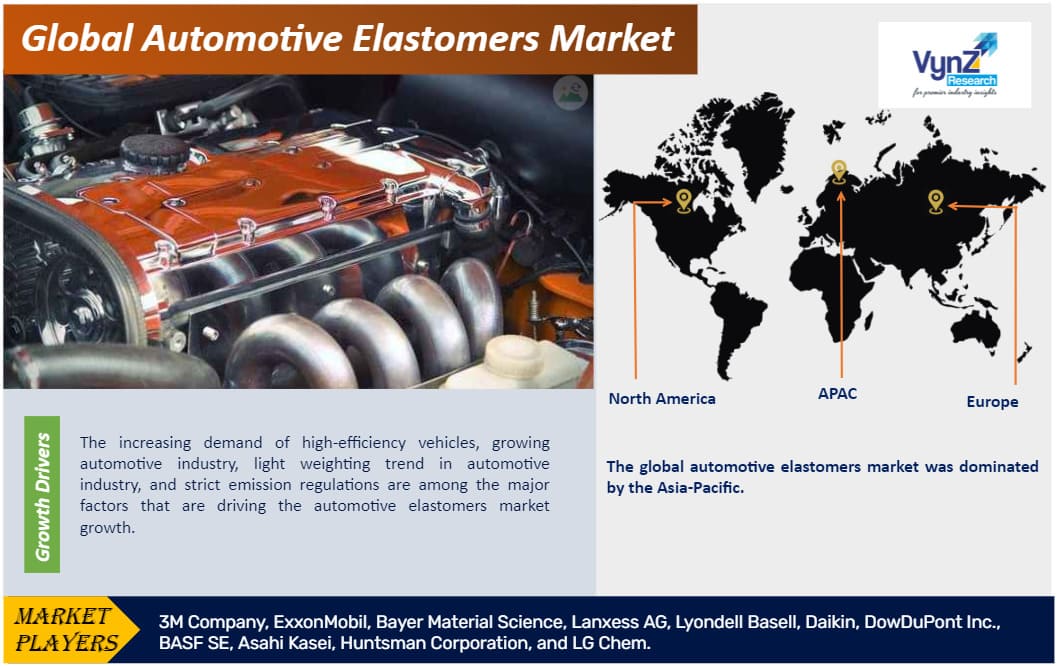| Status : Upcoming | Report Code : VRCH2033 | Industry : Chemicals & Materials | Available Format :

|
Global Automotive Elastomers Market – Analysis and Forecast (2026-2035)
Industry Insights by Type (Natural Rubber, Styrene-Butadiene Rubber, Nitrile Elastomer, Ethylene Propylene Diene Monomer Rubber, Silicone Rubber, Fluroelastomer, Styrene Block Copolymers, Thermoplastic Polyurethane, Thermoplastic Olefin, Thermoplastic Vulcanizates, Thermoplastic Copolyester ), by Application (Tire, Non-Tire), and by Geography (North America, Europe, Asia-Pacific, Middle East, and Rest of the World)
Industry Overview
Elastomers are materials made of polymers which are joined by chemical bond to acquire crosslinked structure. The property of elastomers depends upon the distribution and degree of the polymers chemical bond. The automotive elastomers are used to manufacture different automotive parts. The global automotive elastomers market is registering a good growth in the recent years and also anticipated to grow at a fast pace in the coming years. This is attributed to the increased usage of these elastomers in the automotive industry for wide variety of applications including front-end body panels, belts, hoses, and others.

Automotive Elastomers Market Segmentation
Insight by Type
On the basis of type, the automotive elastomers market is classified into natural rubber, styrene-butadiene rubber (SBR), nitrile elastomer, ethylene propylene diene monomer rubber (EPDM), silicone rubber, fluroelastomer, styrene block copolymers, thermoplastic polyurethane (TPU), thermoplastic olefin (TPO), thermoplastic vulcanizates (TPV), thermoplastic copolyester (TPC), and others. Among all these, natural rubber segment is leading the market and anticipated to register the highest CAGR in the market during the forecast period. This is attributed to the increasing use of this rubber in tire application due to its properties such as excellent tensile strength, tear resistance, elongation, and others.
Insight by Application
Based on application, the automotive elastomers market is segmented into tire and non-tire application. The tire application category is anticipated to dominate the market in the coming years, as 70% of the world rubber is consumed by the tire industry. The industry is witnessing a growth in world tire production due to the growth in automobile industry; hence tire production is among the major force driving the elastomers industry growth. At the same time, the improvement in the variety and quality of elastomers is enabling the tire industry to achieve its goal of providing control, safety, grip, comfort, and other features of tires.
Global Automotive Elastomers Market Report Coverage
|
Report Metric |
Details |
|
Historical Period |
2020 - 2024 |
|
Base Year Considered |
2025 |
|
Forecast Period |
2026 - 2035 |
|
Market Size in 2025 |
U.S.D. xx Billion |
|
Revenue Forecast in 2035 |
U.S.D. xx Billion |
|
Growth Rate |
xx% |
|
Segments Covered in the Report |
By Type, and By Application |
|
Report Scope |
Market Trends, Drivers, and Restraints; Revenue Estimation and Forecast; Segmentation Analysis; Impact of COVID-19; Companies’ Strategic Developments; Market Share Analysis of Key Players; Company Profiling |
|
Regions Covered in the Report |
North America, Europe, Asia-Pacific, Middle East, and Rest of the World |
Industry Dynamics
Automotive Elastomers Market Growth Drivers
The increasing demand of high-efficiency vehicles, growing automotive industry, light weighting trend in automotive industry, and strict emission regulations are among the major factors that are driving the automotive elastomers market growth. The automotive industry is growing at a decent pace, as the production of automobiles has increased to fulfill the demand of the growing population with rising income levels, particularly in Asian countries such as China, India, and others.
Automotive Elastomers Market Challenges
Fluctuating cost of raw material and economic instability in Europe are the major challenges which can hinder the growth of automotive elastomers market. Volatility in the prices of raw materials may adversely affect the performance of elastomers in the global market. There are various factors which impacts the international rubber prices such as crude oil price movement, global supply/demand position, impact on prices of synthetic substitutes, and others, which in turn affects the overall industry.
Recent Developments By the Key Players
BASF officially opened its new Catalyst Development and Solids Processing Center in Ludwigshafen, Germany. This research facility will serve as a hub for pilot-scale synthesis of chemical catalysts, enabling BASF to offer its global customers faster access to innovative technologies. This pilot plant will also be of central importance for the development of new solids processing technologies.
The Japanese technology company Asahi Kasei has introduced a new material solution for enhanced EV battery safety. A flame-retardant and highly flexible nonwoven fabric, LASTAN™ is an outstanding alternative to conventional materials for thermal runaway protection. It can be utilized in top covers, busbar protection sleeves, and other applications within the EV battery pack.
Automotive Elastomers Market Industry Ecosystem
The automotive elastomer industry players are paying attention towards deriving monomers from bio-based sources in order to stay competitive in the market.
Automotive Elastomers Market Geographic Overview
Asia-Pacific is projected lead the automotive elastomers market owing to the increasing demand of elastomers in the transportation and automotive industry. The region is emerging as one of the production hub of automobiles due to the cheap labor, presence of major players, and others, contributing in market growth. Also, the increasing purchasing power of people has triggered the automobiles demand in the region. Hence, a healthy growth prospect in the region’s automotive production is projected to increase the demand for elastomers in the region in the coming years.
Automotive Elastomers Market Competitive Insight
- 3M Company
- ExxonMobil
- Bayer Material Science
- Lanxess AG
- Lyondell Basell
- Daikin
- DowDuPont Inc.
- BASF SE
- Asahi Kasei
- Huntsman Corporation
- LG Chem
Frequently Asked Questions
Purchase Options
Latest Report
Research Methodology
- Desk Research / Pilot Interviews
- Build Market Size Model
- Research and Analysis
- Final Deliverabvle
Connect With Our Sales Team
- Toll-Free: 1 888 253 3960
- Phone: +91 9960 288 381
- Email: enquiry@vynzresearch.com
Automotive Elastomers Market
